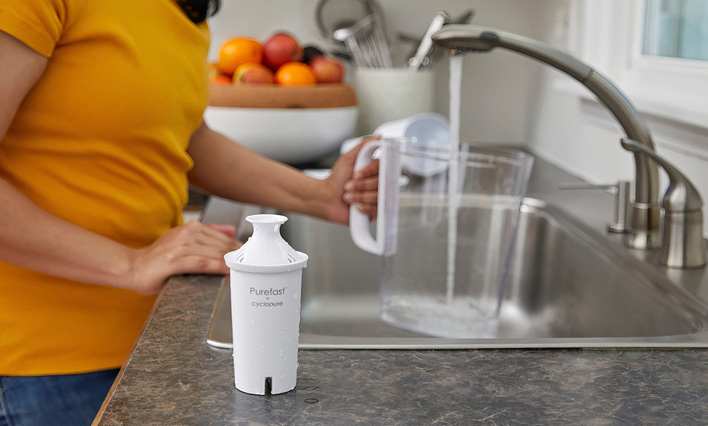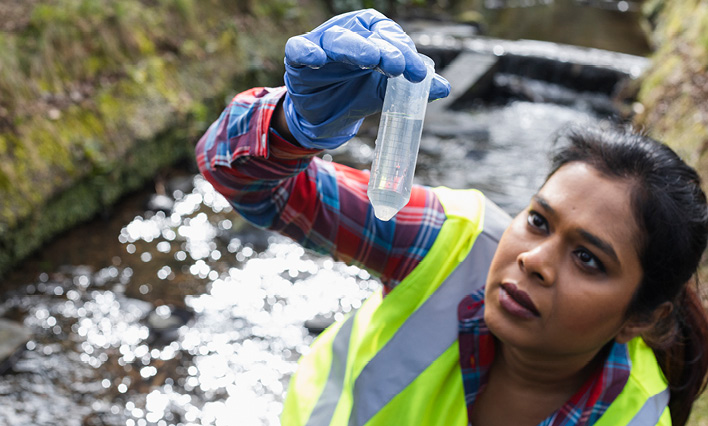What are PFAS?
Per- and polyfluoroalkyl substances (PFAS) are synthetic chemicals that have been used in consumer products around the world since about the 1950s. Because they resist grease, water, and oil, PFAS have been used to make nonstick cookware, firefighting foams, water-repellent clothing, stain-resistant fabrics, and much more.
Why are PFAS harmful?
Experts around the world have linked PFAS to serious health risks. These include increased cholesterol levels, changes in liver enzymes, decreased vaccine response in children, impacts on infant birth weight, increased risk of high blood pressure or preeclampsia in pregnant people, and increased risk of kidney or testicular cancer. Over time, PFAS leak into the soil, water, and air. Since they break down slowly, if at all, people and animals are repeatedly exposed to them, and blood levels of some PFAS can build up over time. A recent Centers for Disease Control and Prevention study found that PFAS are present in the blood of 97% of Americans.
The National Institute of Environmental Health Sciences (NIEHS) funds the Superfund Research Program (SRP), which aims to understand more about PFAS exposures and health effects, among other efforts. Research funded by the SRP has linked PFAS to altered hormones, increased body fat, thyroid issues, and cholesterol issues. Most of these findings come from animal studies, but because many PFAS are thought to harm humans and animals in similar ways, their results can also be applied to people. People living in communities close to Superfund sites—which are contaminated with hazardous waste—were found to have similar exposures to PFAS as the animals in their research studies.

Examples of how per- and polyfluoroalkyl substances (PFAS) enter the environment and water sources.
PFAS are found in drinking water all over the world, including throughout the United States, and are not currently removed using conventional water treatment strategies. More research is needed to find decontamination strategies for PFAS-polluted water, specifically the types and characteristics of PFAS that people are being exposed to and how to trace the sources of contaminants in the water.
NIEHS-supported technology
Another recent study has found a promising new PFAS decontamination strategy. NIEHS and SRP recently funded work with CycloPure Inc. to research how its newly developed technology could remove PFAS from water. With this technology, CycloPure quickly and effectively removed more than 95% of two common PFAS, perfluorooctanoic acid and perfluorooctane sulfonic acid, as well as the other 38 types of PFAS targeted by the U.S. Environmental Protection Agency.

A Purefast™ water pitcher filter by CycloPure Inc., developed with support from the NIEHS Superfund Research Program.
CycloPure’s findings led to the creation of a water filter cartridge compatible with commercial Brita pitchers. These Purefast™ cartridges, which have been available for purchase since early April 2022, are an affordable and effective option to safely decontaminate drinking water. The filters cost $45 and can filter up to 65 gallons of water. Each cartridge comes in a package with a prepaid return label to send used filters back to CycloPure, where the captured toxins can be turned into salts and be disposed of without causing any environmental harm. With the help of environmental engineering firms, CycloPure is testing its technology’s ability to treat large-scale water sources and sustainably provide PFAS-free water.
It’s not enough to just stop producing PFAS since the chemicals are already in the environment and take a long time to degrade. More ways to safely destroy PFAS and decontaminate the environment need to be further researched. With the support of NIEHS and SRP, CycloPure Inc. is piloting cutting-edge technology to decontaminate drinking water in a sustainable way.
Other NIEHS-supported research on exposure to toxic chemicals
Natural History of the Human Biological Response to Environmental Exposure and Injury
Environmental exposures such as pollution, diet, and stress can make human disease more prevalent and severe. Researchers want to better understand environmentally induced injury and inflammation to help develop treatment methods. This study—which is currently recruiting participants—will collect a range of biological samples. Participants’ household dust samples may also be collected. Read more about this study.
Study of Exposure to Chemicals in Consumer Products
Researchers recently completed a study to find better ways to measure people’s exposure to chemicals in household and personal care products. Because manufacturers do not always disclose the exact ingredients in their products, it can be hard to determine the extent to which consumers are exposed. Women ages 35 to 74 who use at least 15 consumer products per day were medically screened and their usage habits recorded by researchers. NIEHS and the U.S. Environmental Protection Agency collaborated on this study. Read more about this research.






